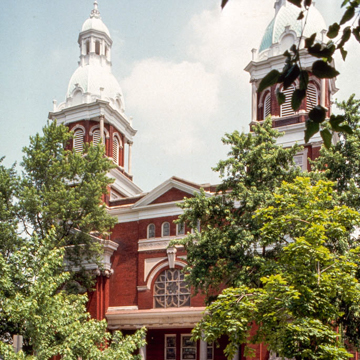You are here
Presbyterian Church (First Presbyterian Church)
This Renaissance Revival Presbyterian Church assumed its present appearance when it was remodeled and enlarged to accommodate the increased size of the congregation. The red brick church was originally built by Congregationalists and Presbyterians. It had a single tall steeple and Romanesque appearance. The instability of the steeple and the need for meeting space for its new organizations, societies, and educational programs prompted the congregation, then the First Presbyterian Society of Ypsilanti, to rebuild and refashion the front facade in 1898–1899. This proved more productive than to repair the steeple and reconstruct the rest of the building. Swiss-born Detroit architect Hess designed the new front in Renaissance Revival. It has spectacular multistaged twin stair and bell towers crowned with cupolas, between which is placed a recessed entrance supported by one-story polished Doric stone columns under a flat lintel with a Doric frieze. Above the entrance in the gabled center section is a circular stained glass window attributed to Tiffany Studios. Hess retained the brick side walls of the building, but embellished their pilasters with Ionic capitals, enlarged the round-arched windows, and installed a new dentiled entablature. From the main entrance, stairs rise to the auditorium, in which three banks of oak pews are arranged around a pulpit. The sanctuary is fitted with beautiful oak woodwork crafted in the Renaissance Revival style. Class and meeting rooms are located underneath the auditorium.
Writing Credits
If SAH Archipedia has been useful to you, please consider supporting it.
SAH Archipedia tells the story of the United States through its buildings, landscapes, and cities. This freely available resource empowers the public with authoritative knowledge that deepens their understanding and appreciation of the built environment. But the Society of Architectural Historians, which created SAH Archipedia with University of Virginia Press, needs your support to maintain the high-caliber research, writing, photography, cartography, editing, design, and programming that make SAH Archipedia a trusted online resource available to all who value the history of place, heritage tourism, and learning.















